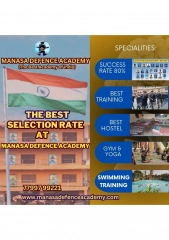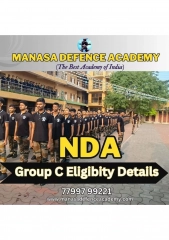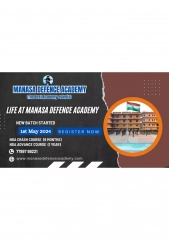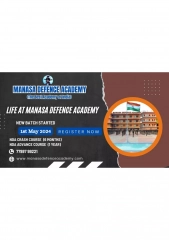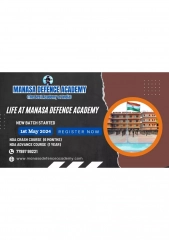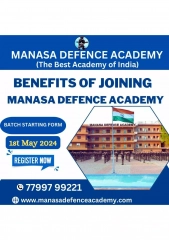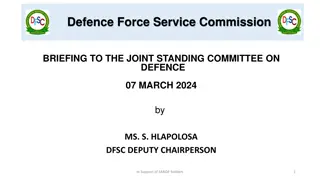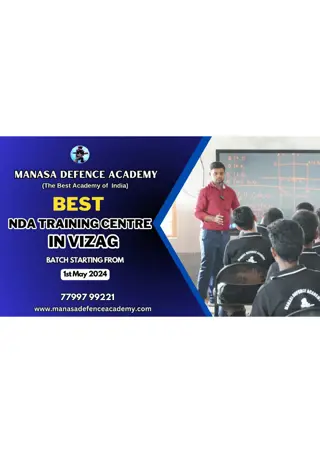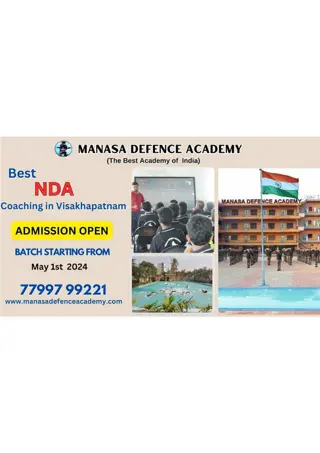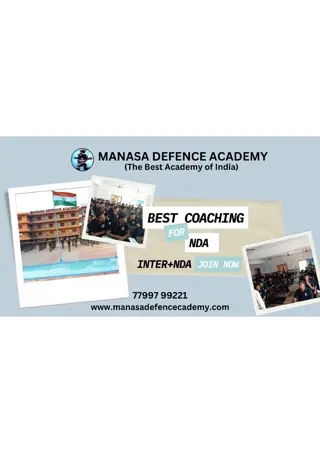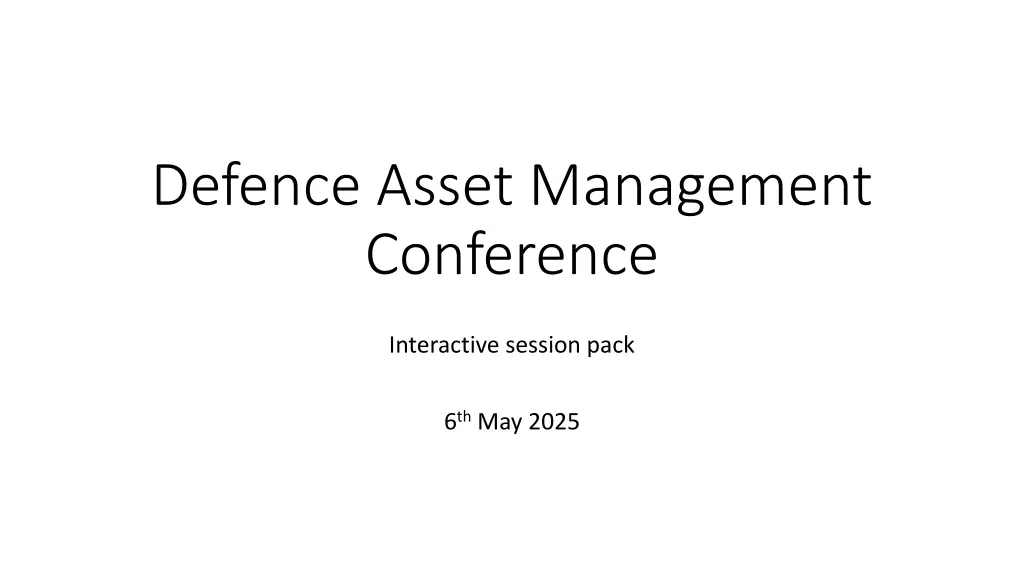
Interactive Session on Defence Asset Management Conference - 6th May 2025
Explore the latest initiatives and projects in Defence Asset Management at the interactive session on the 6th of May 2025. Discover future plans and discussions on how defence functions in the Ministry of Defence. Participate in workshops and reviews to enhance knowledge and collaboration in the field of asset management.
Download Presentation

Please find below an Image/Link to download the presentation.
The content on the website is provided AS IS for your information and personal use only. It may not be sold, licensed, or shared on other websites without obtaining consent from the author. If you encounter any issues during the download, it is possible that the publisher has removed the file from their server.
You are allowed to download the files provided on this website for personal or commercial use, subject to the condition that they are used lawfully. All files are the property of their respective owners.
The content on the website is provided AS IS for your information and personal use only. It may not be sold, licensed, or shared on other websites without obtaining consent from the author.
E N D
Presentation Transcript
Defence Asset Management Conference Interactive session pack 6thMay 2025
Inflight Activities Inflight Activities Workshop task What projects, programmes, initiatives are currently inflight across the 6 box model What future plans do we believe may be in place? Consider how defence works & the different functions in MoD 1. Resources 6/10 Box model- image Paper, pens, Posters, Laptop Convenor Scribe
Inflight Activities Inflight Activities
Collateral Collateral Workshop task SWOT Review & Critique of the collateral What types of collateral would help? 2. Resources DAMCoP Slides Paper, pens, Posters, Laptop Convenor Scribe
Collateral Collateral AM in Defence Infographics / concepts / visualisations Background Due to the nature of AM in defence there are a number of different ways to apply well documented good practice approaches Defence has a substantial number of existing processes, language, solutions that need to be respected in the implementation of AM Often AM can sound like common sense, and is further confused by terms like asset that can be easily confused So what? Collectively it is perceived that AM can increase defence outputs and optimise whole life cost, however it is hampered by silo s within defence. And the not made here barrier Solution? By sharing key concepts that can be linked to wider good practice, and gain a common approach pan defence we have the ability to create common approaches that can bridge language barriers Infographics can provide bitesized concepts, and start conversations that can be used to inform / translate policy into meaningful change Potential future collateral The Asset Management advantage Waste hierarchy & interaction with disposal Asset Management and equipment vs infrastructure
Collateral Review Collateral Review Strengths Weaknesses Opportunities Threats
ASSET MANAGEMENT & INTEGRATED PRODUCT SUPPORT ORGANISATION How does Asset Management support ILS/IPS? What is Asset Management? Provides framework to identify priorities for investment in resources (money, people, infrastructure) framed against organisational outcomes ISO 55000 Clearly articulate the risks / outcomes / consequences of Support design and solution trade-offs during Acquisition Asset Management What is ILS / IPS? How does ILS/IPS support Asset Management? ILS / IPS Management and analytical process that aims to: Design for Support Design of Support Support the Design ALP-10 / SX000i AM Decision-Making framework depends on the asset reference data that ILS/IPS generates EQUIPMENT COMMONALITY WHOLE LIFE THINKING IN DECISION MAKING
ASSET MANAGEMENT & INTEGRATED PRODUCT SUPPORT Asset Management and IPS are complementary. AM is applied at organisation level to ensure effective and transparent decision making from a position of knowledge. AM relies on the asset reference data that IPS generates. Additionally, have we captured the following: AM and IPS have in common the Whole Life consideration in their decision making. Start - Awareness of the value that each discipline brings across the organisation and asset lifecycle AM is a management system that involves the balancing of costs, opportunities and risks against the desired performance of assets to achieve an organisation's objectives. Management - Common language & understanding to enable information & insight to flow FLEET Asset PLATFORM Progress AM is typically applied to organisation, whilst the principles align with those of IPS below. - Clarity of the processes and outcomes that enable difference between the way AM is applied at an organisational level, with clear boundaries & objectives FUNCTION Assess current performance across DLODS SYSTEM Integrated Logistic Support (ILS) / Integrated Product Support (IPS) is a management and analytical process which aims to influence design (from a support perspective) and establish a set of integrated support products based on a single optimized maintenance plan. The process generates a maintenance configuration and associated support data housed in a logistics data repository which is used to aid support information management through-life. Integrated Product GROUP - Digitally enabled decision support tools Excel ITEM Support IPS provides optimised support solutions, resource requirements, and data to enable decision making. - Working as one team with information to influence investment decisions within the organisation and enable visibility of current and future equipment performance - Whole life aggregated articulation of outcomes Progressive assurance C A D M I D ILS/IPS is typically applied to equipment, whilst the principles align with those of AM above. OTHER GOOD PRACTICE Other: tbc Asset Management: Overview - Big Picture Video, DIO tailored version; Anatomy & 39/40 subjects ISO: BS ISO55000:2024 Asset Management IPS JSP . DEF Stan 00-600 & S series
ASSET MANAGEMENT IN DEFENCE INFORMATION SYSTEMS Start Information is the oil of the 21st century and analytics is the combustion engine Systems used to monitor, analyse data to provide insight and support decision making Is data is just 1 s and 0 s until it is used to support a decision to maintain to replace to modify ? - Established Physical & Functional Hierarchies - Data quality baseline understood Did you know there are different types of information system to support decision making, each with different levels of governance and scope? SYSTEM OF INSIGHT - Systems of Record / Insight / Reference / Engagement identified Progress - Systems established as single source of truth, supported by governance High integrity data storage - Good quality data defined, and established as the norm - Data models established for decision making SYSTEM OF RECORD Excel Planning, Execution, history data. Used to inform the data to day management of assets, and is constantly evolving - OTHER GOOD PRACTICE Other: Institute of Asset Management: Subject Specific Guidance 13: Systems Engineering ISO: BS ISO55001:2014 Asset Management
ASSET MANAGEMENT IN DEFENCE DECISION LAYERS Start quantitative and qualitative data on current and future performance - Articulate decisions, and objectives (e.g. in AM Strategy) maintenance scheduling, mission profiling, out of service predictions - Establish objectives to support development of the frameworks - Establish common language & taxonomy Progress GROUP ITEM SYSTEM FUNCTION PLATFORM FLEET - Establish common reporting frameworks - Establish key reporting metrics Physical data structure Functional data structure - Digitally enabled decision support tools determine the appropriate support and maintenance approaches that need to be considered to deliver value to their organisation. Guidance such as the Support Solutions Envelope (SSE) and Common Support Model (CSM) already exist within Defence providing support and tools for organisations to develop their support and maintenance approaches that can be used to enable good AM decisions SYSTEM OF RECORD Understanding the predicted whole life performance of equipment, and the support solution, enables forward focussed decisions to be made that can consider implications of decisions Excel Defence uses Defence Lines of Development (DLOD) to articulate the contents of a support solution including Training, Equipment, Personnel, Infrastructure, Doctrine and Concepts, Organisation, Information, Logistics - Dynamically test interventions to determine if they will move the bottom line Repeatably understand function, redundancy, primacy, mission role, etc - Whole life aggregated articulation of risk & opportunity Adapt to the world around us OTHER GOOD PRACTICE Other: Known in other sectors as Asset Health & Asset Risk these terms can provide confusion. Defence has chosen to retain plain English definitions, but recognises the standards Institute of Asset Management: Subject Specific Guidance XX Asset Health ISO: BS ISO55001:2014 Asset Management SSE: Supportability Analysis JSP .
ASSET MANAGEMENT IN DEFENCE WHAT IS IT? Start There are countless ways of implementing AM, for defence to leverage value its important that the crown, civil servants, military personnel, supply chain, tax payers etc, can find a common language and vocabulary to reduce rework and establish common ways of working By establishing common frameworks changes in the internal and external constraints can be rapidly tested to determine the right action to optimise Defence Outputs. - Common framework of outcomes (e.g. 6 capitals) Decision making across the whole lifecycle of an asset considering Defence Outputs, Financial, Social & Environmental capitals - Understand maturity against a common framework - Establish Common endpoint A whole life focus coupled with the Defence Lines of Development (DLoD) will enable operations and support solutions to be developed that Increase Defence Outputs whilst reducing Whole Life Cost Sustainability Progress Linking AM planning to Defence corporate vision, strategy, policies, plans and objectives SYSTEM OF RECORD ALIGNMENT - Assuring data gathered across the Naval Enterprise to enable improved decision making. This will enable aggregated predictions of current and future performance across the enterprise considering cost and performance Excel Commitment from senior leaders in the Naval Organisations to embrace Asset Management, and provide consistent direction and delegated authority to enable consistent improvement and long term change *Defence outputs in terms of: Readiness, i.e. Availability, Capability, Sustainment - OTHER GOOD PRACTICE Other: Institute of Asset Management: Subject Specific Guidance XX ISO: BS ISO55001:2014 Asset Management 6 Capitals SSE: Supportability Analysis JSP .
ASSET MANAGEMENT IN DEFENCE & THROUGH LIFE ENGINEERING SERVICES
Aspirational Aspirational - - DAMCOP DAMCOP Workshop task What should the future direction of the Defence AM Community of Practice be? Review Manifesto and feedback Should we consider another event to cover other TLB s share progress / insights etc? 3. Aspirational Terms of Reference Paper, pens, Posters, Laptop Convenor Scribe
DAM CoP DAM CoP Proposed Manifesto Proposed Manifesto The Defence Asset Management Community of Practice (DAM-CoP) has a unique opportunity to establish a common framework for undertaking AM across the defence sector. We believe that by establishing common taxonomy and frame work from a blended set of representation from both government and supply chain we can create a streamlined, value add approach. This will create a platform of innovation that can enable all participants across the defence domain to align their actions and complement each others work to the benefit of UK plc. Our intentions: 1. Collaborative Approach: We embrace collaboration across all levels and disciplines to foster a common approach to asset management. 2. Efficiency Enhancement: Our goal is to continually improve efficiency in asset management processes to support defence operations effectively and sustainably. 3. Innovation and Adaptability: We encourage innovation and adaptability to meet evolving defence needs and challenges, leveraging cutting-edge technologies and methodologies. 4. Knowledge Sharing: We promote knowledge sharing and continuous learning within the community to harness collective expertise and insights. 5. Whole Life Cost Reduction: We are committed to reducing whole life costs through strategic planning, proactive maintenance, and lifecycle management practices. 6. Continuous Improvement: We strive for continuous improvement in asset management practices through feedback, evaluation, and adaptation to lessons learned. 7. Ethical and Transparent Practices: We uphold ethical principles and transparency in all asset management activities, ensuring accountability and trustworthiness. It is the intentions of the group to advocate for good practices that yield a return on investment, rather than chase excellence 15

